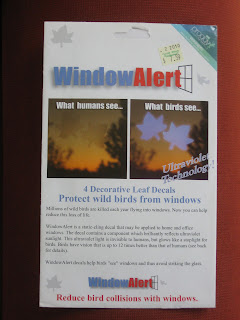Startled, you rush over to the window to see what made the noise, but you already know what happened. It's happened before. You see the smudgy print on the pane of glass and look to the ground below. A bird, one of the ones that comes to the feeders for sunflowers and millet, lies belly-up and toes curled. Another victim of an invisible killer.
I got a call from one of my Birding 101 students last week. A hawk had hit the sliding glass window facing the backyard while she and her husband were out of town for the holidays. She said she thought it might be a young Cooper's hawk and asked if I might know someone who'd want it for scientific purposes.
I said I could make a few calls and asked her to bag it and put it in the freezer for me. I picked the bird up the other day. It is indeed an immature Cooper's hawk (I'm so proud of them for making the correct ID). Now it's in my freezer, awaiting transfer to someone else's freezer, and so-on and so-forth until we can find a university or museum collection or environmental education center that can make use of it.
Though it is relatively uncommon for hawks to strike windows, it is distressingly less so for small songbirds. Window strikes increase exponentially during the winter bird feeding season, when millions of homeowners intentionally attract birds right up to the very edge of that which may break their tiny necks. Are we loving our birds to death?
Studies estimating the number of window-strike mortalities annually puts the figure between 97 and 970 million per year! Many, many of those occur against glass-cover skyscrapers in our largest cities. I don't know of any research that specifically focuses on residential window strikes. Starting this fall during the migration, our tiny, half-acre yard in Black Mountain, NC and its attending windows have claimed a rose-breasted grosbeak, a mourning dove and a song sparrow. Weigh that against the unknown numbers that might survive this winter by our supplemental feeding. How much stock you put into that plus/minus ratio depends on how much credit you give wild birds to take care of themselves during harsh weather. I'm sure some do make it through thanks to the handouts, but I have no idea of a percentage.
Before you despair and take down all of your bird feeders, consider the backyard mortality they're responsible for as a mere drop in the bucket of man-made threats to wildlife. Take pet owners who allow their cats to roam outdoors, for instance. Numerous studies have been done to figure that death count. The numbers range wildly, but even the most-conservative are jaw-dropping. The USFWS estimates approximately 39 million birds are killed by free-ranging domestic and feral cats each year in the state of Wisconsin alone. The national figure is probably around 500 million.
Add pesticides, power lines, vehicle collisions and cell towers to the mix and it's a wonder there are any birds left at all.
 |
| We've had good luck with these. |
Of course, moving feeders away from the house is a good idea too. It all depends on how much you're willing to give up when it comes to the inarguable pleasure of watching wild birds. For Sue and I, it's an unsteady assumption that, with the precautions we take, our backyard birds benefit from our feeding station and we're willing to accept some losses in that effort.
Whether or not we're being selfish and naive or nurturing and benevolent, I doubt we'll ever truly know.


No comments:
Post a Comment